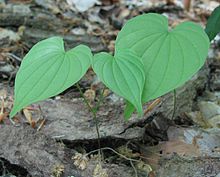Dioscorea villosa is a species of twining tuberous vine which is native to eastern North America. It is commonly known as wild yam, colic root, rheumatism root, devil's bones, and fourleaf yam.[2] It is common and widespread in a range stretching from Texas and Florida north to Minnesota, Ontario and Massachusetts.[1][3][4][5][6]
| Dioscorea villosa | |
|---|---|

| |
| Scientific classification | |
| Kingdom: | Plantae |
| Clade: | Tracheophytes |
| Clade: | Angiosperms |
| Clade: | Monocots |
| Order: | Dioscoreales |
| Family: | Dioscoreaceae |
| Genus: | Dioscorea |
| Species: | D. villosa
|
| Binomial name | |
| Dioscorea villosa | |
| Synonyms[1] | |
| |
Description edit
Dioscorea villosa flower petal color is commonly known to be green to brown, or white. Lengths of the flower petals range from .5 mm to 2 mm. The flowers tend to grow out of the axil; this is the point at which a branch or leaf attaches to the main stem. There is only one flower present on the inflorescence.[verification needed] The fruit of the plant is a capsule that splits and releases the seeds within to then begin the dispersal process[7] The fruit of Dioscorea villosa ranges in size from 10–30 mm.[8] The flower does not produce aerial bulblets.
Taxonomy edit
Synonyms of Dioscorea villosa include Dioscorea hirticaulis and Dioscorea villosa var. hirticaulis. Common names of Dioscorea villosa include wild yam, Atlantic yam, common wild yam, wild yam-root, yellow yam, colic root, and rheumatism root.[9][10][11]
Chemistry edit
Dioscorea villosa contains diosgenin, which despite claims is not a phytoestrogen and does not interact with estrogen receptors.[12] Other steroidal saponins are also found in the plant.[citation needed]
Medical use edit
Some of the English common names of this plant reflect its use in Native American and other traditional medicines.[13] In traditional Russian herbal medicine, saponin extracts from the roots of various varieties of wild yam are thought to be an anticoagulant, antisclerotic, antispasmodic, cholagogue, depurative, diaphoretic, diuretic and a vasodilator.[14]
There is little modern clinical research on Dioscorea villosa, and the one study of a wild yam-containing cream for menopausal symptoms failed to find any value from this therapy.[15] According to the American Cancer Society, there is no evidence to support wild yam or diosgenin being either safe or effective in humans.[16]
References edit
- ^ a b Kew World Checklist of Selected Plant Families
- ^ Gotfredsen, Erik (16 Dec 2018). "Liber Herbarum II". Retrieved 27 Dec 2018.
- ^ Flora of North America
- ^ Govaerts, R., Wilkin, P. & Saunders, R.M.K. (2007). World Checklist of Dioscoreales. Yams and their allies: 1-65. The Board of Trustees of the Royal Botanic Gardens, Kew.
- ^ Biota of North America Program, 2013 county distribution map
- ^ "United Plant Savers". 1 July 2018. Archived from the original on 1 April 2019. Retrieved 27 Dec 2018.
- ^ "Dioscorea villosa (wild yam): Go Botany". gobotany.nativeplanttrust.org. Retrieved 2021-11-11.
- ^ "Dioscorea villosa (Colic root, Wild Yam, Yam-root) | North Carolina Extension Gardener Plant Toolbox". plants.ces.ncsu.edu. Retrieved 2021-11-11.
- ^ "NatureServe Explorer 2.0". explorer.natureserve.org. Retrieved 2021-11-11.
- ^ "Lady Bird Johnson Wildflower Center - The University of Texas at Austin". www.wildflower.org. Retrieved 2021-11-11.
- ^ "Wild Yam (Dioscorea villosa)". www.illinoiswildflowers.info. Retrieved 2021-11-11.
- ^ Medigović I, Ristić N, Živanović J, Šošić-Jurjević B, Filipović B, Milošević V, Nestorović N (2014). "Diosgenin does not express estrogenic activity: A uterotrophic assay". Can J Physiol Pharmacol. 92 (4): 292–8. doi:10.1139/cjpp-2013-0419. PMID 24708211..
- ^ Austin, DF (2004). Florida Ethnobotany. Boca Raton: CRC Press. p. 267. ISBN 9780849323324.
- ^ Zevin, Igor Vilevich. A Russian Herbal. 1997. Rochester, Vermont: Healing Arts Press. p.146-47.
- ^ Geller SE, Studee L (2005). "Botanical and dietary supplements for menopausal symptoms: What works, what doesn't". J Womens Health (Larchmt). 14 (7): 634–49. doi:10.1089/jwh.2005.14.634. PMC 1764641. PMID 16181020..
- ^ "Wild Yam". American Cancer Society. November 2008. Archived from the original on 2 May 2015. Retrieved 21 September 2013.
Further reading edit
- http://www.nlm.nih.gov/medlineplus/druginfo/natural/970.html
- Eagon PK, Elm MS, Hunter DS, et al. Medicinal herbs: modulation of estrogen action. Era of Hope Mtg, Dept Defense; Breast Cancer Res Prog, Atlanta, GA 2000;Jun 8-11.